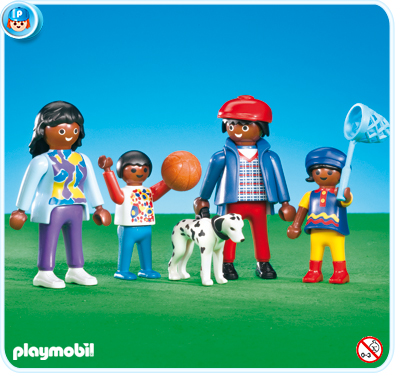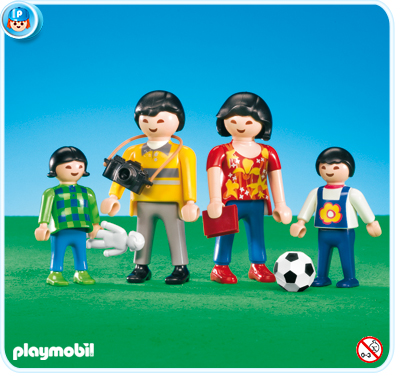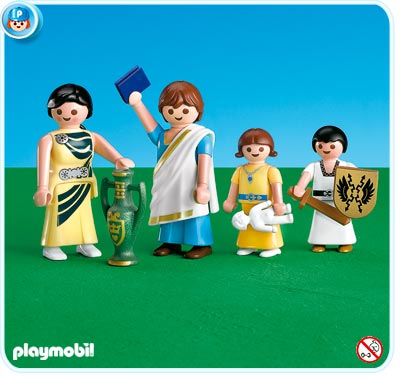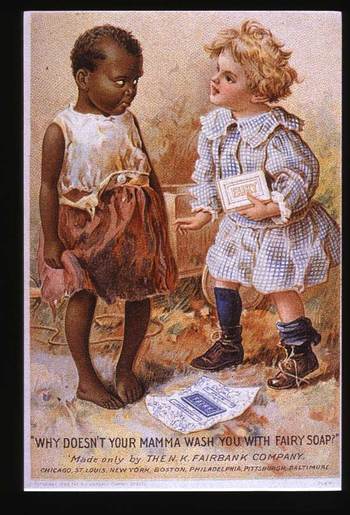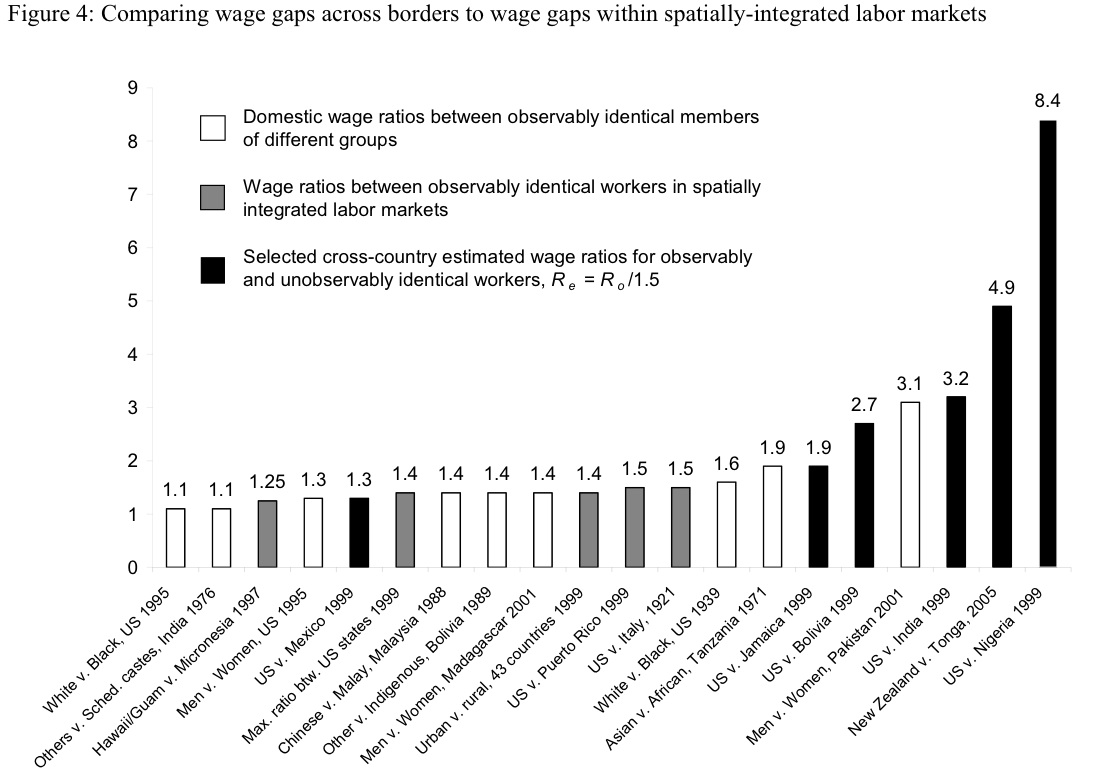Coal Black and de Sebben Dwarfs (found here):
race/ethnicity
Kirsten D. sent us this link to a series of Playmobil families. She notes how the families are all racially marked (using racial categories like “Asian” and “African” instead of nationality categories like “Japanese” and “Somalian”). The “Mediterranean/Hispanic” category also points to the social construction of race and the way in which social construction varies across cultures (Playmobil are made in Germany).
They families are also racially homogeneous. In the world of Playmobil (at least how it is sold, though not necessarily how it is played with) there are no interracial families and, therefore, no bi- or multi-racial people. In this way the toys reify racial categories and naturalize racial matching in relationships.
African/African American Family:
Mediterranean/Hispanic Family:
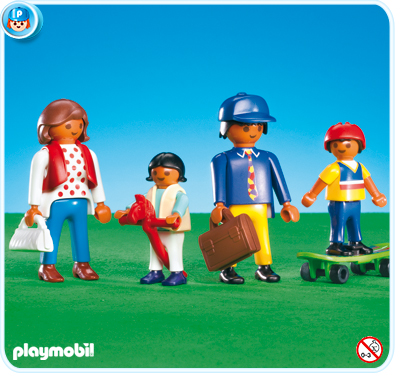
Asian Family:
Native American Family:
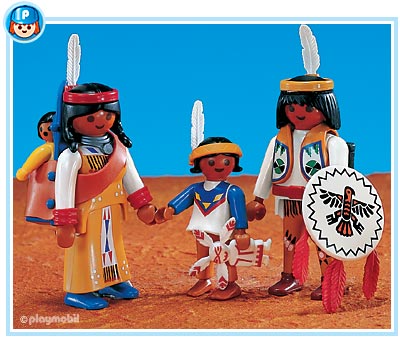
Notice also that all of the families are in contemporary clothes except for the Native American family. Ethnicized groups are often represented in “native” costume, but this is especially true for American Indians (at least in the U.S.). It is as if, in the popular imagination, American Indians are extinct; as if there are no American Indians alive today walking around in Nikes (there are).
So, in the world of Playmobil, American Indians are, like Romans, a historical artifact:
Also, because it warrants pointing out, all the female and male children all have gender stereotypical toys.
I am writing a lecture about the social construction of race/ethnicity and wanted to show some pictures of people who are grouped into a single racial category in the U.S. but, in fact, show enormous variety in their skin tone, facial features, etc., so I quickly googled the phrase “African American skin tone.” And I found this flyer for a party at a club where light-skinned women would get in free ( found here):
My reactions, in order: “What the f**k???” “This is clearly made up.” [After finding this AP story about it]: “Son of a bitch! It’s real!” Due to the outcry, the event was canceled and the event planner expressed sorrow and dismay that he would have offended anyone. Because who could have guessed this would be problematic?
This image should be perfect for illustrating a number of topics, such as the way hierarchies often emerge within racial groups based on skin tone, facial features, etc., so that racial discrimination does not just occur between different groups, or the way that light skin is still prized in our society, even in racial/ethnic minority populations. You could also focus on the gender angle and compare it to photos of African American women who are often “whitened” or required to have light skin tone in order to be models, actresses, etc. (for example, see this post), or the whole issue of why clubs allow women, but not men, in for free.
I’m going to pair this image with Margaret Hunter’s article “Light, Bright, and Almost White: The Advantages and Disadvantages of Light Skin” (from Skin/Deep: How Race and Complexion Matter in the ‘Color-Blind’ Era, 2004).
Ben O. forwarded this ad for Fairy Soap (found here). It plays into the idea that African Americans are dirty and either lazy or stupid (since they don’t bother to wash their children), but that enlightened, kindly, clean whites can help them. It would make a good accompaniment to the chapter “Soft-Soaping Empire: Commodity Racism and Imperial Advertising” in Imperial Leather: Race, Gender, and Sexuality in the Colonial Contest, by Anne McClintock.
UPDATE: In a comment, Brendon proposed a reading I didn’t think of:
The second ad is troubling, but my interpretation of it wasn’t that the ad was implying that African Americans are dirty – it’s implying that the young white girl believes the black girl is covered in dirt, which is the only reason why the black girl doesn’t have the white skin she does. It’s about the ‘folly’ of youth – this girl isn’t versed in the discourse of racial difference yet!
Of course, Eric points out that the “cutesy” element is undermined by the fact that the ad was made by adults who, unless we’re both totally wrong, didn’t hold such an “innocent” view of the differences between African Americans and Whites.
Also, as a commenter pointed out, given changes in hairstyles and dress for children over time, it may be those are boys, not girls.
NEW (July ’10)! Monica Y. sent along another example, this one an ad for Vinolia Soap:
Real Americans are white people and we shouldn’t forget it.
Fox News Anchor Jane Skinner called a woman on the U.S. Olympic softball team a “great representative” because she was “blonde” and “blue-eyed.” See it here.
Thanks to Caroline H. for the link!

Can’t make this stuff up. See also this post on white privilege.
(From Skin Coloured.)
Z from It’s The Thought That Counts sends us this figure showing the wage gap between various types of groups. The point is to show that wage differentials are most extreme across countries, not within them. In an article, Kerry Howley writes:
Wage gaps between observably identical Nigerian workers in the United States and Nigerian workers in Nigeria (same gender, education, work experience, etc) are… considerable. They swamp the wage gaps between men and women in the US. They swamp the gaps between whites and blacks in the US. Actually, they swamp the wage gaps between whites and blacks in the United States in 1855. For several countries, the effect of border restrictions on the wages of workers of equal productivity “is greater than any form of wage discrimination (gender, race, or ethnicity) that has ever been measured.” The labor protectionism that keeps poor workers out of rich countries upholds one of the largest remaining price distortions in any global market.
Click here for the full research report.
Ghanimah A. sent us these images for Cordaid, an “international development organisation” that specializes in “emergency aid and structural poverty eradication.” We would love to know what you think.
Kirsten D. sent us this link to a series of Playmobil families. She notes how the families are all racially marked (using racial categories like “Asian” and “African” instead of nationality categories like “Japanese” and “Somalian”). The “Mediterranean/Hispanic” category also points to the social construction of race and the way in which social construction varies across cultures (Playmobil are made in Germany).
They families are also racially homogeneous. In the world of Playmobil (at least how it is sold, though not necessarily how it is played with) there are no interracial families and, therefore, no bi- or multi-racial people. In this way the toys reify racial categories and naturalize racial matching in relationships.
African/African American Family:
Mediterranean/Hispanic Family:

Asian Family:
Native American Family:

Notice also that all of the families are in contemporary clothes except for the Native American family. Ethnicized groups are often represented in “native” costume, but this is especially true for American Indians (at least in the U.S.). It is as if, in the popular imagination, American Indians are extinct; as if there are no American Indians alive today walking around in Nikes (there are).
So, in the world of Playmobil, American Indians are, like Romans, a historical artifact:
Also, because it warrants pointing out, all the female and male children all have gender stereotypical toys.
I am writing a lecture about the social construction of race/ethnicity and wanted to show some pictures of people who are grouped into a single racial category in the U.S. but, in fact, show enormous variety in their skin tone, facial features, etc., so I quickly googled the phrase “African American skin tone.” And I found this flyer for a party at a club where light-skinned women would get in free ( found here):
My reactions, in order: “What the f**k???” “This is clearly made up.” [After finding this AP story about it]: “Son of a bitch! It’s real!” Due to the outcry, the event was canceled and the event planner expressed sorrow and dismay that he would have offended anyone. Because who could have guessed this would be problematic?
This image should be perfect for illustrating a number of topics, such as the way hierarchies often emerge within racial groups based on skin tone, facial features, etc., so that racial discrimination does not just occur between different groups, or the way that light skin is still prized in our society, even in racial/ethnic minority populations. You could also focus on the gender angle and compare it to photos of African American women who are often “whitened” or required to have light skin tone in order to be models, actresses, etc. (for example, see this post), or the whole issue of why clubs allow women, but not men, in for free.
I’m going to pair this image with Margaret Hunter’s article “Light, Bright, and Almost White: The Advantages and Disadvantages of Light Skin” (from Skin/Deep: How Race and Complexion Matter in the ‘Color-Blind’ Era, 2004).
Ben O. forwarded this ad for Fairy Soap (found here). It plays into the idea that African Americans are dirty and either lazy or stupid (since they don’t bother to wash their children), but that enlightened, kindly, clean whites can help them. It would make a good accompaniment to the chapter “Soft-Soaping Empire: Commodity Racism and Imperial Advertising” in Imperial Leather: Race, Gender, and Sexuality in the Colonial Contest, by Anne McClintock.
UPDATE: In a comment, Brendon proposed a reading I didn’t think of:
The second ad is troubling, but my interpretation of it wasn’t that the ad was implying that African Americans are dirty – it’s implying that the young white girl believes the black girl is covered in dirt, which is the only reason why the black girl doesn’t have the white skin she does. It’s about the ‘folly’ of youth – this girl isn’t versed in the discourse of racial difference yet!
Of course, Eric points out that the “cutesy” element is undermined by the fact that the ad was made by adults who, unless we’re both totally wrong, didn’t hold such an “innocent” view of the differences between African Americans and Whites.
Also, as a commenter pointed out, given changes in hairstyles and dress for children over time, it may be those are boys, not girls.
NEW (July ’10)! Monica Y. sent along another example, this one an ad for Vinolia Soap:
Real Americans are white people and we shouldn’t forget it.
Fox News Anchor Jane Skinner called a woman on the U.S. Olympic softball team a “great representative” because she was “blonde” and “blue-eyed.” See it here.
Thanks to Caroline H. for the link!

Can’t make this stuff up. See also this post on white privilege.
(From Skin Coloured.)
Z from It’s The Thought That Counts sends us this figure showing the wage gap between various types of groups. The point is to show that wage differentials are most extreme across countries, not within them. In an article, Kerry Howley writes:
Wage gaps between observably identical Nigerian workers in the United States and Nigerian workers in Nigeria (same gender, education, work experience, etc) are… considerable. They swamp the wage gaps between men and women in the US. They swamp the gaps between whites and blacks in the US. Actually, they swamp the wage gaps between whites and blacks in the United States in 1855. For several countries, the effect of border restrictions on the wages of workers of equal productivity “is greater than any form of wage discrimination (gender, race, or ethnicity) that has ever been measured.” The labor protectionism that keeps poor workers out of rich countries upholds one of the largest remaining price distortions in any global market.
Click here for the full research report.
Ghanimah A. sent us these images for Cordaid, an “international development organisation” that specializes in “emergency aid and structural poverty eradication.” We would love to know what you think.

